2 August 2024 : Daily Current Affairs
1. 4 dead as cloudbursts wreak havoc in Himachal Pradesh
- 1. 4 dead as cloudbursts wreak havoc in Himachal Pradesh
- 2. ‘Proper diet key to managing childhood obesity, diabetes’
- 3. Mental health matters: the psychological pressures of UPSC preparation
- 4. Supreme Court Allows Sub-classification in SC/ST Quotas, Overturns 2004 Ruling
- 5. Identifying the ‘creamy layer’: model of OBC reservation
- Prelims Facts
- 1. Disaster Management Bill tabled in Lok Sabha
- 2. Japan gives nod to hunt second largest animal, fin whale
- 2. Climate Change Threatens Future of Gouda’s Historic Cheese Market
- 3. Swapnil Kusale Wins Bronze, Marks Historic Day for Indian Shooting at Paris Olympics
- 4. NATIONAL MISSION ON MONUMENTS AND ANTIQUITIES
- 4. PM VISHWAKARMA YOJANA
(Source – The Hindu, International Edition – Page No. – 4)
| Topic: GS3 – Disaster And Disaster Management |
| Context |
|
Disaster Management for Cloudbursts:
Understanding Cloudbursts
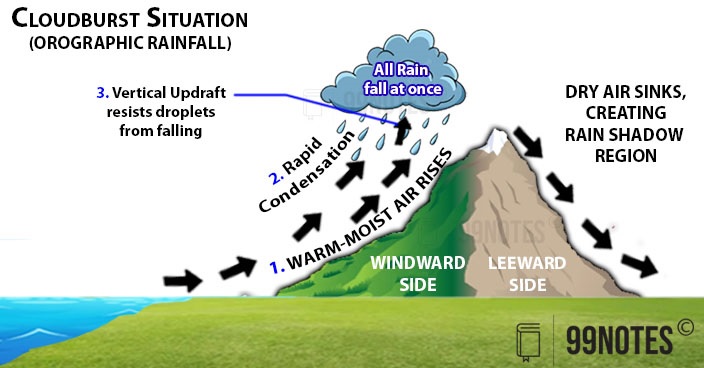
- Definition:
- A cloudburst is a sudden, intense rainfall event that results in a rapid discharge of rain over a small area, often causing flash floods.
- Characteristics:
- Typically occurs in mountainous or hilly regions.
- Short duration but with extremely high rainfall intensity.
Causes and Impact
- Causes:
- Topographic effects: Orographic lifting where moist air is forced upwards by mountains.
- Atmospheric instability: Rapid cooling of air that leads to condensation and heavy rainfall.
- Localised weather phenomena such as thunderstorms.
- Impact:
- Flash floods: Sudden rise in water levels leading to immediate flooding.
- Landslides: Saturation of soil can trigger landslides in hilly areas.
- Property damage: Destruction of infrastructure, homes, and roads.
- Loss of life and injury: Risk to human lives and livestock.
Preparedness and Mitigation Measures
- Early Warning Systems:
- Implementation of weather forecasting tools and satellite monitoring to predict cloudbursts.
- Dissemination of alerts through local media, mobile apps, and community networks.
- Community Awareness:
- Public education on recognizing cloudburst signs and immediate response actions.
- Conducting community drills and workshops on emergency preparedness.
- Infrastructure Development:
- Construction of rainwater harvesting systems and drainage channels to manage sudden runoff.
- Strengthening of embankments and riverbanks to prevent flooding.
- Building resilient infrastructure that can withstand sudden weather changes.
Response and Relief Operations
- Emergency Response:
- Activation of local disaster management teams and coordination with state and national agencies.
- Deployment of rescue operations and provision of first aid and medical care to affected individuals.
- Relief Measures:
- Provision of temporary shelter, food, and clean drinking water to displaced populations.
- Assessment of damage and initiation of repair and rebuilding activities.
- Psychological support and counselling services for affected individuals.
- Coordination:
- Collaboration between government agencies, NGOs, and community-based organisations for effective relief and rehabilitation.
- Use of technology such as GIS and remote sensing for damage assessment and resource allocation.
Long-Term Strategies
- Infrastructure Resilience:
- Integrating disaster risk reduction in urban planning and construction codes.
- Regular maintenance and upgrading of drainage systems and flood protection infrastructure.
- Research and Development:
- Investment in research to improve prediction models and develop better mitigation technologies.
- Implementation of best practices and lessons learned from past cloudburst events.
- Policy Framework:
- Formulation of comprehensive disaster management policies focusing on cloudbursts and other extreme weather events.
- Strengthening legal frameworks for disaster preparedness and response at local and national levels.
| Practice Question: Discuss the key disaster management strategies for mitigating the impact of cloudbursts in mountainous regions. Highlight the importance of early warning systems, community preparedness, and infrastructure development. (250 Words /15 marks) |
2. ‘Proper diet key to managing childhood obesity, diabetes’
(Source – The Hindu, International Edition – Page No. – 7)
| Topic: GS2 – Social Justice – Health |
| Context |
|
Analysis of the news:
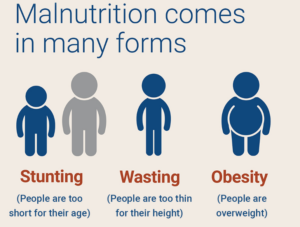
Current Statistics on Child Malnutrition
- Recent Findings: Women and Child Development Minister Annapurna Devi revealed in the Lok Sabha that:
- 17% of children aged 0–5 years in India are underweight.
- 36% are stunted (low height for age).
- 6% are wasted (low weight for height).
- Indicators of Malnutrition: These statistics reflect severe malnutrition issues among young children, including deficiencies in essential nutrients.
Definition and Scope of Malnutrition
- WHO Definition: Malnutrition includes deficiencies or excesses in nutrient intake, an imbalance of essential nutrients, or impaired nutrient utilisation.
- Double Burden of Malnutrition: The WHO describes this as encompassing both undernutrition (e.g., stunting and wasting) and issues related to overweight, obesity, and diet-related noncommunicable diseases.
Historical and Ongoing Challenges
- Persistent Issue: India has faced malnutrition challenges for decades, with 56.4% of the total disease burden attributed to unhealthy diets.
- Dietary Guidelines: According to the Indian Council of Medical Research (ICMR)-National Institute of Nutrition (ICMR-NIN), there is a significant problem of impaired nutritional status among children alongside rising rates of overweight, obesity, and pre-diabetic conditions, creating a dual burden of malnutrition.
Addressing the Diabesity Pandemic
- Prevention efforts should focus on promoting adolescent and female health during reproductive years, rather than solely targeting adults and using biologics.
- Indians face a disadvantage due to a longstanding nutritional backlog.
- This leads to the “thrifty phenotype,” where malnourishment causes excessive fat storage when food availability increases, leading to insulin resistance and diabetes.
Challenges to Food Security
- New food security challenges exacerbate existing nutritional deficits.
- Factors such as climate change, droughts, unseasonal rain, and global price fluctuations impact the availability and affordability of nutritious food.
- Impact on Diet: Rising food prices lead to reduced consumption of diverse, nutrient-rich foods. Pregnant women and young children are particularly vulnerable, often receiving less nutritious food when prices increase.
| Practice Question: Discuss the dual burden of malnutrition in India, focusing on the prevalence of undernutrition and obesity among children. Analyse the factors contributing to this issue and suggest comprehensive strategies to address it. (250 Words /15 marks) |
3. Mental health matters: the psychological pressures of UPSC preparation
(Source – The Hindu, International Edition – Page No. – 11)
| Context |
|
Recent Incident and Systemic Lapses
- A recent flood in a Delhi coaching institute highlighted the precarious living conditions of UPSC aspirants.
- This tragic event has underscored systemic issues and the intense pressures faced by students, impacting their mental health.
Overwhelming Pressure Factors
- Academic Rigour: UPSC preparation demands studying 10-12 hours daily, leading to sacrifices in sleep, social life, and self-care.
- Current Events: Constantly staying updated adds to the stress, creating a cycle of anxiety.
- Self-Induced Pressure: Nearly half of the students experience frequent self-imposed pressure, with one-third reporting anxiety about under-performance.
- Peer and Family Pressure: About 36% of students face peer pressure, and 24% face family pressure.
Economic Pressures
- Financial Investment: Many aspirants come from low-income backgrounds, with significant financial investment in preparation.
- Family Income: A majority of students have a family income between ₹30,000 and ₹50,000 or less, with many from families dependent on farming or skilled/semi-skilled work.
- Coaching Fees: Annual coaching fees range from ₹1 to ₹3 lakh, adding to financial burdens.
- Additional Costs: Housing, meals, and other expenses further strain finances.
- Financial Support: 20% of students find family support insufficient; 30% take part-time jobs or offer tuition, while others borrow money or cut costs.
Exam Integrity Concerns
- Paper Leaks: Recent leaks of NEET and UGC NET exams have heightened concerns about exam integrity.
- UPSC Exam Worries: About one-third of students fear potential leaks in UPSC exams, with 19% worried ‘a lot.’
Impact on Mental Health
- Pre-existing vs. New Stress: Many students reported increased feelings of loneliness, stress, fear, frustration, and sadness since starting preparation.
- Mental Health Trends: Four in ten students reported improved mental health, while three in ten experienced worsening conditions; two in ten saw no change.
Coping Mechanisms
- Support Systems: A majority have confidants to share feelings, though 22% lack such support.
- Healthy Coping Strategies: Common methods include watching TV or listening to music (38%), physical exercises or meditation (30%), and reaching out to family (30%).
- Unhealthy Coping Methods: Some students resume studying under stress (10%) or use substances like smoking or alcohol (6%). Alarmingly, 2% do not know how to manage stress.
Seeking Professional Help
- Therapy: 19% of students felt the need for therapy, but only 6% sought professional help due to barriers like cost, judgement, and lack of access.
- Medication: 10% of students have used sleeping pills or anti-depressants since starting their preparation.
Conclusion
- The UPSC exam journey is demanding, impacting students’ mental health significantly.
- Addressing mental health through self-care, support systems, and professional help is crucial for maintaining resilience and well-being. Recognizing the importance of mental health is essential for ensuring students are prepared both academically and mentally/
| Practice Question: Discuss the impact of financial and mental health pressures on UPSC aspirants and suggest measures to improve support systems for them. (150 Words /10 marks) |
4. Supreme Court Allows Sub-classification in SC/ST Quotas, Overturns 2004 Ruling
(Source: Indian Express; Section: Explained; Page: 17)
| Context: |
|
Analysis of News:
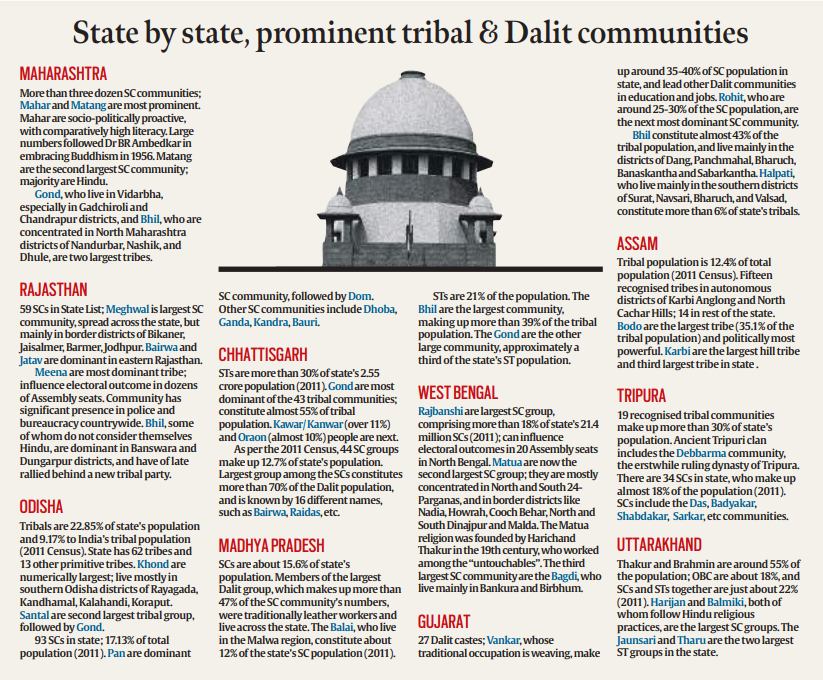
Background
- Article 341 of the Constitution allows the President to list SCs who suffered from historical injustices like untouchability, granting them a 15% reservation in education and public employment.
- Over time, it was observed that some groups within the SC list were underrepresented. Attempts by states to address this issue faced judicial scrutiny.
- For instance, Punjab’s 1975 notification giving preference to Balmiki and Mazhabi Sikh communities was struck down by the Court in 2004.
Key Issues
- Homogeneity of SC List: The Court in E V Chinnaiah held that the SC list must be treated identically, assuming no internal differences. The recent judgment rejected this premise, stating the list is a “legal fiction” and recognizing internal disparities within SCs.
- State Powers for Sub-classification: Articles 15(4) and 16(4) of the Constitution empower states to make special provisions for SCs and provide reservations in public employment. The new judgment allows states to identify varying degrees of social backwardness and create sub-quotas, provided they demonstrate a need for wider protections with empirical evidence.
- Criteria for Sub-classification: States must present a reasonable rationale and quantifiable data to justify sub-classifications. Representation in public services should be effective, not merely numerical, ensuring that disadvantaged SC communities achieve meaningful representation.
- Creamy Layer Principle: Justice Gavai advocated for applying the creamy layer principle to SCs and STs, similar to OBCs. This concept, supported by four of the seven judges, aims to ensure that the most disadvantaged members of a community benefit from reservations.
Conclusion
- The Supreme Court’s judgment marks a significant shift in India’s reservation policy, addressing internal inequalities within SC and ST categories.
- By allowing sub-classifications, the ruling aims to provide more targeted protections and achieve effective representation for the most disadvantaged communities.
- However, states must carefully justify these classifications with empirical data and reasonable rationale.
| What are the Constitutional Provisions Related to Reservations in India? |
|
Part XVI of the Constitution of India deals with the reservation of SC and ST in Central and State legislatures. Article 15 of the Constitution empowers the State to make the following provisions:
Article 16 provides for the grounds of positive discrimination or Reservation in government jobs.
Article 243D provides reservation of seats for SCs and STs in every Panchayat. Article 335 of the constitution says that the claims of STs and STs shall be taken into consideration consistently with the maintenance of efficacy of the administration. Articles 330 and 332 provide for specific representation through the reservation of seats for SCs and STs in the Parliament and in the State Legislative Assemblies respectively. |
| PYQ: Whether National Commission for Scheduled Castes (NCSCJ) can enforce the implementation of constitutional reservation for the Scheduled Castes in the religious minority institutions? Examine. (150 words/10m) (UPSC CSE (M) GS-2 2018) |
| Practice Question: Discuss the implications of the Supreme Court’s recent decision to allow sub-classification within the Scheduled Castes (SC) and Scheduled Tribes (ST) quota for the purpose of providing targeted protections to the most disadvantaged communities. How does this ruling address historical inequalities, and what challenges might arise in its implementation? (250 words/15 m) |
5. Identifying the ‘creamy layer’: model of OBC reservation
(Source: Indian Express; Section: Explained; Page: 17)
| Topic: GS2 – Social justice |
| Context: |
| The Supreme Court’s recent decision to permit sub-classification within the Scheduled Castes (SC) and Scheduled Tribes (ST) for the purpose of granting separate quotas for the most backward communities within these categories is a historic shift in India’s reservation policy. |
Analysis of News:
Key Highlights of the Ruling
Sub-Classification Permitted:
- In a 6:1 verdict, the court allowed states to create sub-classifications within the SC and ST categories, overturning the 2004 decision in E V Chinnaiah v State of Andhra Pradesh. This earlier ruling had treated SC/ST as a homogeneous group, not allowing further division.
Chief Justice’s Opinion:
- Chief Justice DY Chandrachud and the majority held that SC/ST groups are not internally homogeneous and that sub-classifications could ensure more equitable distribution of reservation benefits.
- They emphasized that the inclusion in the Presidential list of SCs/STs does not create a uniform class devoid of internal disparities.
Criteria for Sub-Classification:
- States must provide empirical evidence to justify the need for sub-classifications and demonstrate that the most disadvantaged groups within the SC/ST categories are inadequately represented.
What is Creamy layer:
- The 27% reservation for OBC was upheld by the Supreme Court in the Indra Sawhney case (1992). It opined that caste is a determinant of class in the Indian context.
- However, in order to uphold the basic structure of equality, it fixed a cap of 50% for reservation unless there are exceptional circumstances. The court also provided for exclusion of creamy layer from OBC.
- The criteria for identifying a person as part of the creamy layer is based on the recommendations of the Justice Ram Nandan Prasad Committee (1993).
- It is determined by the position/income of an applicant’s parents alone.
- The criteria for belonging to creamy layer is parental income, excluding income from salary and agricultural income, being more than ₹8 lakh in each year in the last three consecutive financial years.
Categories of applicants are also considered as belonging to creamy layer:
(a) parents, either of whom entered government service (centre or State) as Group A/Class I officer or parents, both of whom entered as Group B/Class II officers or father, who was recruited in Group B/Class II post and promoted to Group A/Class I before 40 years of age;
(b) either of the parents employed in a managerial position in PSUs;
(c) either of the parents holding constitutional posts.
Creamy Layer Concept for SC/ST:
- Justice B R Gavai’s opinion suggested that a ‘creamy layer’ criterion, similar to that for Other Backward Classes (OBCs), should be applied to SCs and STs to exclude the more advanced individuals within these groups from reservation benefits.
- However, this approach would need to be tailored specifically to SCs and STs, recognizing their unique socio-economic circumstances.
Challenges and Implementation
Empirical Evidence Requirement:
- States will need to gather comprehensive data to support the creation of sub-classifications, ensuring that the most disadvantaged communities within SC/ST categories receive adequate representation.
Criteria for Creamy Layer:
- Determining a ‘creamy layer’ within SCs and STs presents a complex challenge.
- The criteria may need to differ from those applied to OBCs due to the deep-seated historical and social injustices faced by SCs and STs.
Potential Resistance:
- The concept of a creamy layer and sub-classification may face resistance from certain SC/ST communities that fear loss of benefits or further marginalization.
Conclusion
- The Supreme Court’s ruling is a significant step towards addressing inequalities within the SC/ST categories. By allowing sub-classification and suggesting the introduction of a creamy layer concept, the court aims to ensure that reservation benefits reach the most disadvantaged groups.
- However, the implementation of these changes will require careful consideration, robust data collection, and potentially new legislative frameworks to address the unique challenges faced by SCs and STs.
| Practice Question: Discuss the recent Supreme Court ruling permitting sub-classification within Scheduled Castes (SC) and Scheduled Tribes (ST) for reservations. How does this ruling impact the implementation of affirmative action policies, and what challenges might arise in formulating criteria for identifying the ‘creamy layer’ within these communities? (250 words/15 m) |
Prelims Facts
1. Disaster Management Bill tabled in Lok Sabha
(Source – The Hindu, International Edition – Page No. – 4)
| Context |
|
Analysis of the news:
- Union Minister of State for Home, Nityanand Rai, introduced the Disaster Management (Amendment) Bill, 2024, in the Lok Sabha on Thursday.
- The Bill proposes the creation of a national and State-level disaster database.
- It mandates the establishment of an Urban Disaster Management Authority for State capitals and major cities with municipal corporations, excluding Delhi and Chandigarh.
- The disaster database will include information on disaster assessment, fund allocation, expenditure, preparedness and mitigation plans, risk registers, and other relevant details as per Union government policy.
- The Bill empowers the National Disaster Management Authority (NDMA) and State Disaster Management Authorities to prepare disaster plans at the national and State levels, replacing the previous roles of the National Executive Committee and State Executive Committees.
- NDMA is also authorised to appoint experts and consultants as needed.
- Opposition members criticised the Bill for creating multiple authorities and encroaching on State government functions.
2. Japan gives nod to hunt second largest animal, fin whale
(Source – The Hindu, International Edition – Page No. – 15)
| Context |
|
Analysis of the news:
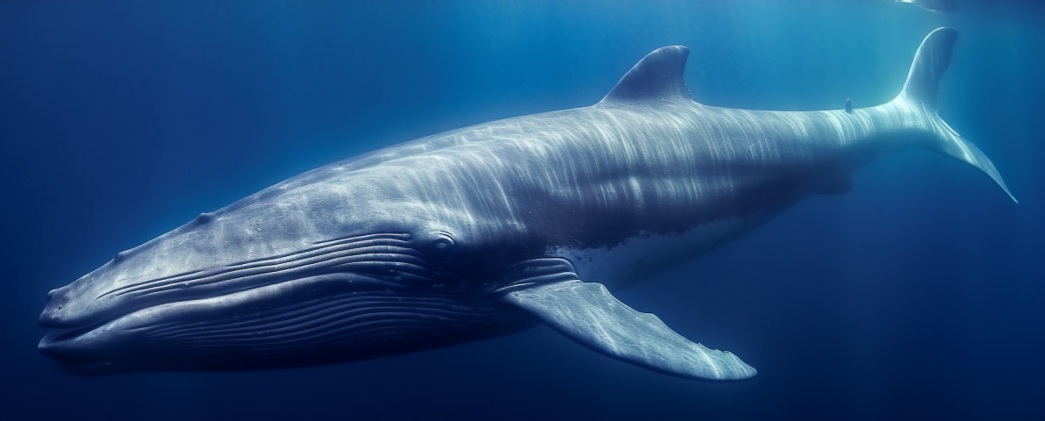
- Species: Fin whales (Balaenoptera physalus) are the second-largest animal species on Earth, after blue whales.
- Size: Adults can reach lengths of up to 85 feet (26 metres) and weigh up to 80 tons.
- Appearance: They have a sleek, streamlined body with a dark grey or brownish-grey colour and lighter undersides.
- Habitat: Found in oceans worldwide, from the polar to temperate regions. They migrate seasonally between feeding grounds in polar waters and breeding grounds in tropical waters.
- Diet: Primarily feed on small schooling fish and krill, using their baleen plates to filter prey from the water.
- Conservation Status: Classified as “Vulnerable” by the International Union for Conservation of Nature (IUCN) due to historical whaling and ongoing threats from ship strikes, entanglement in fishing gear, and climate change.
- Behaviour: Known for their fast swimming, reaching speeds of up to 23 miles per hour (37 km/h), and can often be seen breaching or showing their dorsal fins.
2. Climate Change Threatens Future of Gouda’s Historic Cheese Market
(Source: Indian Express; Section: The World)
| Context: |
|
Analysis of News:

Setting and Context
- Gouda, a small city in the Netherlands, is known for its cheese market dating back to the Middle Ages.
- The market is now more of a tourist attraction, with actual price negotiations happening elsewhere.
Economic Significance
- Gouda’s cheese industry is significant, producing 60% of the Netherlands’ cheese with an export value of $1.7 billion annually.
Future Challenges
- Experts predict the cheese market may not exist in 50-100 years due to environmental threats.
- The city is built on peat marsh, making it vulnerable to sinking and flooding, exacerbated by climate change.
Climate Change Impact
- Increased rainfall and rising sea levels threaten the river delta where Gouda is located.
- Predictions suggest the region, known as the Green Heart, could be inundated or require floating cities by the century’s end.
Current Mitigation Efforts
- Gouda spends over $22 million annually on water mitigation, expected to rise.
- Experts calls for a radical new approach within 10 years, criticizing the lack of urgency in addressing these issues.
3. Swapnil Kusale Wins Bronze, Marks Historic Day for Indian Shooting at Paris Olympics
(Source: Indian Express; Section: Cover Page; Page: 01)
| Context: |
|
Analysis of News:
Event and Performance
- Kusale competed in the 50m rifle 3-position event, known for its difficulty.
- He won a bronze medal, becoming an Olympic medalist at 28.
Achievements and Impact
- Kusale’s bronze contributed to India’s tally of three bronze medals in shooting at the Paris Olympics.
- It was the first time India won three medals in a single sport at the same Olympics.
- His victory is part of a broader resurgence in Indian shooting, which had faced back-to-back setbacks in previous Olympics.
| No. | Athlete | Event | Sport | Medal |
| 1 | Manu Bhaker | Women’s 10m air pistol | Shooting | Bronze |
| 2 | Manu Bhaker-Sarabjot Singh | Mixed team 10m air pistol | Shooting | Bronze |
| 3 | Swapnil Kusale | Men’s 50m rifle 3 positions | Shooting | Bronze |
4. NATIONAL MISSION ON MONUMENTS AND ANTIQUITIES
(Source – https://pib.gov.in/PressReleseDetail.aspx?PRID=2040119 )
| Topic: GS2 – Governance – government policies |
| Context |
|
Establishment and Purpose:
- Established in 2007 by the Government of India.
- Aims to create two national databases: one on monuments and another on antiquities.
Target Audience:
- Databases intended for public use, including students, researchers, educational institutions, and administrative personnel.
- Conducts training programs and workshops nationwide on documenting monuments and antiquities.
Collaborations:
- Works with the Archaeological Survey of India (ASI) to engage with foreign academic and research institutions.
- Partnerships aim to access innovative research and restoration techniques.
- Collaborations with international institutes such as the University of Ca’ Foscari, Venice, and ICR, Italy.
Technological and Research Support:
- Memorandum of Understanding (MoU) with IIT Gandhinagar for strengthening archaeological sciences.
- Focus areas include material analysis, documentation, structural stability, seismic vulnerability, and dating techniques.
- Supports studies on paleo-environment, archaeology, and archaeo-seismology.
4. PM VISHWAKARMA YOJANA
(Source – https://pib.gov.in/PressReleseDetail.aspx?PRID=2040261 )
| Topic: GS2 – Governance – government policies |
| Context |
|
Analysis of the news:
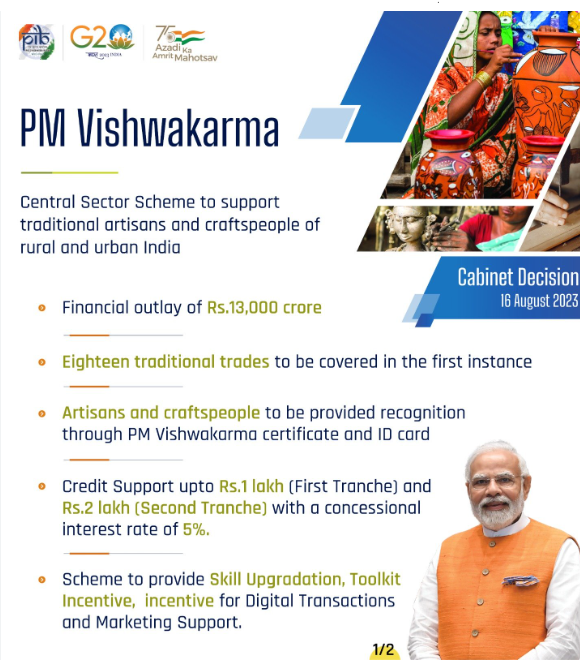
- Objective: Launched by the Prime Minister on September 17, 2023, the PM Vishwakarma Yojana aims to provide comprehensive support to artisans and craftspeople who work with their hands and tools across India.
- Components:
- Recognition: Artisans receive a PM Vishwakarma Certificate and ID Card, acknowledging their skills and contributions.
- Skill Upgradation: Training programs are available to enhance the skills of artisans, ensuring they stay competitive and proficient in their crafts.
- Toolkit Incentive: Artisans receive incentives for acquiring necessary tools, aiding in better productivity and quality of work.
- Credit Support: Financial assistance is provided to facilitate access to credit, enabling artisans to expand and sustain their businesses.
- Incentive for Digital Transactions: Encouragement and rewards for adopting digital transaction methods to enhance financial inclusion and ease of business.
- Marketing Support: Assistance in marketing products, helping artisans reach broader markets and increase their income.
- Implementation: The scheme is implemented nationwide with significant enrolment and registration numbers indicating strong participation.
- Case study: In Chikkaballapur district, Karnataka, 97,356 applications were received, with 17,696 successful registrations, showcasing the scheme’s reach and impact.
- Administration: Managed by the Ministry of Micro, Small, and Medium Enterprises, aligning with the government’s focus on boosting the traditional crafts sector.



